[Page 79]Abstract: Did Nephi intentionally use chiasmus in his writings? An analysis of fifteen multi-level chiasm candidates in Nephi’s writings demonstrates a high statistical probability (99%+) that the poetic form was used intentionally by Nephi but only during two specific writing periods. This finding is buttressed by further analysis, which reveals a clear and unexpected literary pattern for which Nephi seems to have reserved his usage of chiasmus. The nature of obedience is a major theme in Nephi’s writings, and he regularly employed chiasms to explore the topic early in his writings. After a period during which he discontinued use of the technique, he returned to the poetic device toward the end of his life to signal a significant shift in his thoughts on the topic of obedience.
John W. Welch’s discovery of chiasmus in the Book of Mormon has sparked both lay and scholarly interest among Latter-day Saints in the study of inverted parallels. Initially something like chiasmus-mania seemed to sweep among LDS scholars.1 Donald W. Parry, for instance, reformatted the text of the Book of Mormon, emphasized its poetic forms, and noted that “more than 300 examples of chiasmus exist in the Book of Mormon.”2 Since many of these writers have been influenced by the world of biblical studies and specifically the poetic form chiasmus, LDS scholars have seemed less interested in studies of other inverted parallel forms, such as ring composition and palindromic structure.3 There has been a surge of interest recently in the study of ring forms, with pundits considering whether or not these types of inverted parallel structures are found in literature as diverse as Homer, Plato, ancient Chinese philosophical writings, Beowulf, Paradise Lost, Harry Potter, and Star Wars.4
[Page 80]Two types of inverted parallels dominate the discussion: (a) short passages organized in a relatively straightforward chiastic pattern (e.g., ABCC’B’A’) and (b) larger works purposely structured using ring form or some other model of inverted parallelism. Long assumed an ancient literary technique, recent scholars have begun to question the traditional assumption that inverted parallelism died out “around the middle of the fifth century BCE.”5 These arguments are based on larger organizing forms of inverted parallelism that typically encompass an entire document rather than short chiastic passages. Thus, while Rachel Barney claims the traditional belief that ring form died out in the fifth century “is clearly false,” she notes, “in fairness, much of the early scholarship on ring-composition … focuses on the small-scale rings used to structure speeches and digressions in epic and tragedy, not the larger structures.”6
LDS scholars have proposed both short and lengthy uses of inverted parallelism in the Book of Mormon. Hundreds of examples of the simplest forms, two-level chiasms such as Alma 40:23 (The soul shall be restored to the body, and the body to the soul), have been identified and catalogued. At the other extreme, LDS authors have claimed that entire books are structured chiastically. Welch, for example, argues that the entirety of 1 Nephi is organized using a chiastic structure with “almost every element in the first half of the book having a specific counterpart in the second half.”7
Inherent to these conversations about inverted parallelism is the question of what constitutes an intentional versus a random occurrence. Extremely short chiastic sequences (i.e., ABB’A’), despite their aesthetic appeal, can easily occur by chance without being necessarily intended by the author.8 On the other hand, long ring forms can seem so arbitrary that it is difficult to determine whether the author intended to use the structure or if its discovery simply reflects the “artifice of the reader.”9 Quite frankly, it is extremely difficult to determine objectively the intentionality of either of these two extremes: the shortest of the chiasms (ABB’A’) or the longer ring forms.10 However, for inverted parallels that fall in between these extremes, it is easier to develop objective and measurable criteria to assess intentionality.
In this article I examine Nephi’s use of simple, multilevel chiasms (or small ring forms) and argue that he employed inverted parallelism for specific literary purposes.11 Thus I imply and attempt to test intentionality on the author’s part. But my findings are much more nuanced and surprising than this relatively straightforward question of intentionality. I also argue that as we come to understand how Nephi [Page 81]used inverted parallelism, we as readers can unlock a heretofore under-appreciated message that Nephi intentionally wished to convey.
Determining the Intentionality of Chiastic Passages
Scholars have identified a number of conventions or laws associated with inverted parallels. In 1942 Nils Lund proposed seven laws of chiastic structures,12 and in 1995 John W. Welch published fifteen criteria for evaluating and identifying chiastic structures.13 Whereas both Lund and Welch’s lists apply to both short and long inverted parallels, Mary Douglas offered her own list of “seven rules or conventions from long ring compositions.”14 While Douglas’s self-proclaimed focus is long rings, her list proves useful when studying shorter rings as well.
But does the existence of a number of these conventions in a text mean that an author consciously intended to use inverted parallelism? Welch argues that these “criteria can assist in establishing a presumption of intent” but acknowledges that we cannot know with 100% certainty.15
By analyzing proposed chiasms thoroughly and from a number of angles, one can assess the likelihood that an author consciously employed chiasmus in a given case to achieve a specific purpose. Nevertheless, one can rarely speak with absolute certitude in this area, since few writers ever produce commentaries on their own works. Moreover, there will probably be some circularity in one’s analysis here, for some of the factors used to determine the degree of chiasticity presume some degree of intentionality (e.g., purpose), yet those factors will be relied upon in answering the question of whether the structure was intentionally created.16
In addition, in an effort to quantify mathematically the likelihood of intentionality, Edwards and Edwards used four of Welch’s criteria and developed a statistical approximation of the likelihood of a random appearance of a chiasm, given its length, complexity, and other characteristics.
From this statistical analysis, one can infer, in some cases, that chiastic structure was likely created intentionally by its author, that is, by design. We distill Welch’s four quantitative criteria into a single quantity L, the ‘reordering’ likelihood that n-element chiastic structure could have appeared by chance in a particular passage … we also calculate the chiastic probability, P, that such structure could have appeared by [Page 82]chance anywhere in the larger work from which the passage was taken … 17
Figure 1 summarizes all three authors’ listed criteria as well as Edwards and Edwards’s methodology for calculating L and P-values.18 Several common themes emerge across these three sets of rules. First, a well-designed inverted parallelism should begin and end at the same place, and longer ones are often introduced by a prologue that highlights [Page 83]the overall message. Douglas comments that “the final section signals its arrival at the end by using some conspicuous key words.”19 Second, the author’s primary message is found at the center of the inverted structure. According to Welch, Lund “asserts this as the first and foremost law of chiasmus.”20 Welch adds “without a well-defined centerpiece or distinct crossing-effect, there is little reason for seeing chiasmus.”21 Third, the structure has to be demonstrably inverted. The second half of the ring must repeat the first half in inverted order.
For the purposes of the remainder of this discussion, I will focus on what I consider these three most important requirements for determining the intentionality of a proposed inverted parallelism: (a) an interconnected beginning and ending, (b) the key theme of the passage placed at the center of the inversion, which should also mark a noticeable turning point, and (c) a multi-level sequence of ideas and/or words that repeat in inverted fashion. And while I will use Edwards and Edwards’s quantitative model to help measure this third requirement, I will not rely upon it exclusively to determine inversion. I have listed the main criteria that I will use for the remainder of this analysis in Figure 2. I am contending that inverted parallels are most likely to be intentional if they have a clear literary purpose, have an interconnected beginning and ending, have a complex multi-level chiastic structure that is unlikely to have been generated by chance, and are centered on a climatic passage especially relevant to the author. While other considerations remain important and will be considered secondarily, if these primary requirements are not reasonably met, it is significantly less likely that an inverted parallelism was created intentionally.
Nephi’s Use of Chiasmus
[Page 84]My analysis of Nephi’s use of inverted parallels will focus on small to medium-sized chiasms as opposed to larger, book-level structures. John W. Welch has argued that both 1 Nephi and 2 Nephi are individually organized using chiastic form. Other LDS scholars, however, have proposed alternative organizing structures for Nephi’s writings, including an Exodus motif, a Creation-Fall-Atonement-Veil structure, parallelism that is not inverted, and two separately organized writings whose point of demarcation is 2 Nephi 5.22 Thus, there are a number of proposed organizing structures for approaching Nephi’s writings. Since I have enough emotional scars from years of refereeing LDS church basketball, I have no desire to bring a whistle into this fray. So this paper and I will remain on the sidelines with regard to the question of whether or not Nephi organized either of his books in chiastic or ring form.
Nevertheless, even though I have eliminated the book-level structuring questions, evaluating Nephi’s use of small to medium-size chiasms remains a Herculean task. LDS scholars have proposed hundreds of smaller chiasms in Nephi’s writings. One resource website lists 408 1 Nephi passages that have been proposed as chiastic.23 The vast majority of these candidates are short, two or three-level chiasms.24 Unfortunately with regards to our task for determining intentionality, these smaller chiasms, by their very definition, have a much higher probability of random occurrence than longer chiasms and generally do not exhibit the same climatic literary impact. Although there is an appealing poetic symmetry to an ABB’A’ pattern, there is generally not a dramatic buildup to a pivoting central point or a sense of linkage to the beginning at the closure. Therefore, I have chosen to ignore the vast majority of these candidates to make my analytic task manageable.25
I have selected Donald W. Parry’s reformatted Book of Mormon text as my starting point for identifying chiastic passages as candidates for further analysis in order to determine intentionality.26 Using this text, I have identified fifteen possible inverted word order passages that are four level or higher and are attributable to Nephi as the primary author.27 I then analyze these specific passages to determine (a) if there is evidence that Nephi wrote these passages intentionally using the aforementioned criteria and (b) if there is a discernible literary pattern that might explain his desire to use this particular poetic form.
Recently I argued that Nephi’s record spanned four writing periods spread across forty years.28 This assertion is a departure from the traditional assumption that Nephi composed his record over a short [Page 85]period late in his life.29 See Figure 3 for a summary of these periods along with the frequency of inverted parallelism employed by Nephi during each of them. The frequency of Nephi’s use of chiasms was greatest as he recorded his early history on the large record (which he later used to abridge onto these “other” plates). A possible explanation for this difference is the likelihood that these stories were told orally for a number of years in the wilderness until, as Nephi informed us, he was instructed to fashion his first set of plates. Nephi’s later writings contain much less history and were therefore less likely to have been transmitted orally. Regardless of the reason, it is clear that Nephi’s chiasm rate differed significantly across the timeline (e.g., there are no chiastic candidates in his final appendix). Thus I will use the proposed authorship timeline as an anchor for my remaining analysis.
[Page 86]I wish to begin my analysis of these fifteen candidates mathematically. Before we examine a candidate passage’s closure or centrality, we need to determine if it is organized using inverted word order. Using Edwards and Edwards’s equations, we can calculate the probability that the inverted word order of each of these fifteen candidates occurred randomly. The first calculation, L, is the likelihood that a chiasmus of n-levels could happen randomly, given both additional occurrences of chiastic elements and the repeating non-chiastic elements found within the specific passage. For example, 1 Nephi 3:3–12 is a seven-level chiasm, but detailed examination of that passage reveals that five of the chiastic elements repeat twice, another element repeats four times, and one element repeats five times. There are also four non-chiastic elements in the passage that each repeat twice.30 Applying these characteristics into Edwards and Edwards’s formula, the L-value for 1 Nephi 3:3–12 is calculated at .016. This means there is only a 1.6% chance that this chiasm occurred randomly, given the chiastic and non-chiastic elements.31 Stated differently, when just this one isolated example is considered independent of the remainder of Nephi’s writings, there is a 98.4% chance that this chiasm was written by design rather than by chance (1-L).32
The broader context of an author’s work, however, needs to be considered when mathematically assessing candidates. If 1 Nephi 3:3–12 was the only chiastic example that occurred across all of Nephi’s writings, then we would need to adjust our formula to account for all possible opportunities for chiasms in the text (i.e., the volume).33 Based on the timeline of composition (Figure 3), I have calculated chiastic opportunities for three different subsets of Nephi texts: (a) his abridged writings, (b) his historical text, and (c) his prophecies.34 Finally, I have attempted to adhere to Edwards and Edwards’s “strict selection rules,” including their requirement that “two or more appearances of a single literary element must share the same essential word or words.”35 These rules generally mean that the quantitative analysis is less subjective to reader interpretation and far more conservative than any ring form analysis that I have ever read.
The quantitative results for the fifteen chiasm candidates are shown in Table 1. These results support the conclusion that during two specific periods (Nephi’s abridged writings and his prophecies), Nephi intentionally used chiasmus as a poetic technique. During the other two times (his late history and his appendix), however, it is likely that Nephi did not purposely utilize the technique. The single chiastic candidate in Nephi’s late history, 1 Nephi 1:16–18, fails our statistical [Page 87]test of intentionality. It has an L-value of 25.27%. When placed into the broader context of Nephi’s writings during this period, the statistical probability that this stand-alone chiasm is due to chance (P) is 99.88%.36 Of course, this does not necessarily mean that Nephi did not write this passage intentionally. It is important to look at other factors to make the case for it’s being written by design. My own analysis of these other factors, however, leads me to conclude that the case for the intentionality for this chiasm is relatively weak, and therefore, for the remainder of this paper, I assume there is a low likelihood that Nephi’s late history contains intentional chiasms with four or more levels.37
[Page 88]On the other hand, there is a very high statistical likelihood that four of the ten abridged candidates and three of the four prophecy candidates were purposely composed using the chiastic form.38 For example, abridged candidate 1 Nephi 3:3–12 is 99.94% likely to have been composed intentionally, and prophecy candidate 2 Nephi 25:24–27 is 99.98% likely. These results justify the conclusion that there is a greater than 99% probability that portions of Nephi’s abridged text (1 Nephi 1–18) and his prophecies (2 Nephi 6–30) were written intentionally in inverted parallelism.
Again, this does not mean the lower probability candidates were not written intentionally. Edwards and Edwards tell us that “moderate and large P-values say absolutely nothing about intentionality. The author of a passage with a moderate or large value of P may well have intentionally invoked the chiastic form in composing the passage, but such a value simply provides no evidence that she did, nor does it provide evidence that she did not.”39 In fact, the number of candidates during these two periods with a high probability of intentionality lends credence to the likelihood that other, less complex candidates were also intentional. An examination of these passages with higher L-values, however, requires us to look more in-depth at a passage’s centrality, closure, and design.
Nephi’s Stories of the Wilderness Were Recorded
in Chiastic Form
Of the ten candidates that Nephi seemed to have copied from the abridged record, do they all appear intentional, or are some random? We have already determined that statistically four of the ten have P-values that suggest a high probability they were created by design. But this is only one tool of many when determining intentionality. We need to look at each candidate individually across our broader set of criteria and assess each one’s chiastic likelihood. Let’s start by examining Nephi’s first chiasm candidate, 1 Nephi 3:3–12. Recall from Table 1 that the P-value for this chiasm is .0006, which implies an extremely high mathematical likelihood of intentionality. A closer qualitative look at the text and how it is structured provides more illumination as to Nephi’s purpose for choosing to organize this passage as a chiasm. Here are the text highlights organized in chiastic form.
[Page 89]
The first criterion to consider is closure. Notice how distinctive are Nephi’s beginning and ending. 1 Nephi 3:3 reads “Laban hath the record of the Jews and also a genealogy of my forefathers, and they are engraven upon plates of brass” and corresponds with 1 Nephi 3:12, which reads “and he desired of Laban the records which were engraven upon the plates of brass, which contained the genealogy of my father” (underlines highlight the corresponding items). There are six items that directly correspond within the beginning and within the ending. This alerts the reader that this is meant to be a start and an end to a ring. The repetition of such a detailed set of items into a single element is a powerful indicator of an intentional chiasm. Another aspect of closure from ring composition is the existence of a prologue that introduces the primary theme of the passage. This obviously is more common with longer inverted parallelisms and therefore is not a requirement of smaller chiasms. Still, this chiastic candidate is immediately preceded by the following verse:
Behold I have dreamed a dream, in the which the Lord hath commanded me that thou and thy brethren shall return to Jerusalem. (1 Nephi 3:2)
Nephi used Lehi’s words to provide a prologue that matches well with the overall theme of the chiasmus. So this particular candidate has a prologue as well as a series of six corresponding key words that mark the beginning and end; both fulfill our criteria for the closure attribute.
Another important criteria is centrality. When we examine the center of this chiasm, we find a scripture that is both one of the most beloved scriptures from the Book of Mormon and one that is commonly associated with Nephi. The crux of this story is Nephi’s willingness to keep God’s commandments — a topic that he returned to again and [Page 90]again in his writings. What better way to highlight this message than to place it at the climatic center of a chiasm?
I will go and do the things which the Lord hath commanded, for I know that the Lord giveth no commandments unto the children of men, save he shall prepare a way for them that they may accomplish the thing which he commandeth them. (1 Nephi 3:7)
This passage also relates well with the prologue, where Lehi tells Nephi the “Lord hath commanded” him to return to Jerusalem. At this point the chiasm candidate also demonstrates an antithetical shift. Until this moment, Nephi has been paraphrasing Lehi and his requests of Nephi and his brethren. At the pivot point, however, Nephi becomes the main character as he pledges his willingness to obey the commandments, and he begins to relate how he would ultimately accomplish the specific tasks assigned by Lehi.
Because 1 Nephi 3:3–12 fulfills our criteria (both qualitative and quantitative) for an intentional chiasm, there can be very little doubt that Nephi wrote this by design. It is a seven-level chiasm with a less than 1% statistical probability of being by chance. It has a distinctive beginning/ending with six specific items repeated. It builds to a climax and ultimately centers on one of the most famous of Nephi’s passages. It has a prologue that introduces this central theme. What if we were able to see similar chiastic construction in Nephi’s abridged writings with similar literary purposes? Would these similarities also bolster the likelihood that this and those candidates were also designed intentionally? I argue that the case for intentionality is strengthened with further repetition of this specific literary pattern among other chiastic candidates.
Figure 4 summarizes my assessment of the intentionality of each of the ten chiastic candidates from Nephi’s abridged writings. When we look at the manner in which Nephi used chiasmus in his abridged history, a noticeable literary pattern emerges as we specifically consider the criteria of centrality. Of the ten inverted candidates from the abridged time, nine center on a distinctive pattern, a pattern so logical and compelling that I feel it argues for intentionality even when we have relatively high P-values.
[Page 91]
Consider another example that is less obviously chiastic than 1 Nephi 3:3–12. In 1 Nephi 17:48–52 Nephi recounted a story about how his brothers sought to throw him into the sea. This story, as a chiasm candidate, it is the weakest statistically of those from the abridged time (P-value of .9137). In the absence of other factors, we would likely conclude that this candidate was not intentional. When we compare the passage’s literary purposes to Nephi 3:3–12 and other candidates in addition to considering other criteria, an illuminating theme emerges that argues for intentionality. Here are the highlights of the inverted parallelism.[Page 92]
While there is no prologue to this short episode, the ending and closing are clearly marked by the phrase “lay their hands upon me.” In addition, the central message of this passage is Nephi’s faith that he can accomplish anything that the Lord commands him to do. Although this story is about rebuking his brethren, Nephi centers it exactly the same way as before: he will do everything that he is commanded. The similarity in message is so powerful that there must be something intentional happening here. Due to the ring-like closure to this story, the consistency of the central message with other candidates, and the distinctiveness of the beginning/ending language, I argue that this candidate is probably intentional despite it only having four-levels and a high P-value.
So far we have analyzed two of the proposed candidates from Nephi’s abridged writings and, surprisingly, have found that both times Nephi used a chiastic structure to emphasize a similar theme: the importance of God’s commandments and his words. This is a remarkable consistency and argues in favor of intentionality with candidates that have higher P-values.
What of the remaining eight abridged inverted passages? Do they employ the chiastic form for similar literary purposes? The answer, remarkably, is yes. Of the ten abridged candidates, eight highlight aspects of the same core theme at their center. In other words, as shown in Figure 5, Nephi’s abridged text returned, over and over, to the chiastic form to underscore the message of the importance of following the words and commandments of the Lord. Due to the remarkable consistency in Nephi’s message across these eight chiasms, I argue that it is highly improbable that these candidates occurred by chance.40 The account from which Nephi abridged this portion of the text regularly used chiasms to tell of the family’s travels in the wilderness. Nearly every time Nephi utilized an inverted parallelism, he did it in order to emphasize the theme of obedience and the importance of the word of God. Of the two candidates in the abridged text that do not fit this pattern, I conclude that 1 Nephi 5:1–6 is likely not chiastic, and the other, as I discuss later, serves [Page 93]as an important thematic bridge between Nephi’s abridged writings and his much later prophecies and commentaries.
Why Did Nephi Return to the Chiastic Form?
The proposed authorship timeline presented earlier in Figure 3 suggests that Nephi authored his “Prophecy” texts (2 Nephi 6–30) approximately thirty years after he authored his “Abridged” texts (1 Nephi 1–18 minus his editorial asides). During this time gap he wrote what the timeline terms his “historical” texts (1 Nephi 19 to 2 Nephi 5 plus his editorial asides) [Page 94]and, as discussed earlier, he did not appear to purposely employ chiasms in these texts. But Nephi chose to return to the inverted word order form with a handful of distinctly chiastic passages in his “prophecy” texts after thirty years of disuse. Why? Was there a literary reason for Nephi’s return to the form? A detailed examination of these chiasm candidates offers a plausible explanation that serves to heighten the reader’s appreciation of the text’s literary depth and, quite frankly, brilliance.
First, we should examine the four possible chiastic candidates in Nephi’s prophecy period (2 Nephi 6–30). Figure 6 summarizes my analysis of each of these candidates’ intentionality. I rate three of the four candidates as highly likely to be chiastic, and so the bulk of our remaining discussion will focus on them. Assessing the chiasticity of 2 Nephi 26:1–9, however, is more problematic. It does not fit the proposed pattern, it has a high P-value, and the central meaning is nebulous. While I consider it possible that this an intentional chiasm, the resolution of this issue does not affect my underlying conclusions about Nephi’s writings from this period, and therefore I do not spend further time on this specific candidate.
Recall that the dominant theme of Nephi’s earlier chiasms was obedience and the importance of following the word of the Lord. Eight times within the text that Nephi abridged, we find chiasms centered on this theme. I wish now to return to the one aforementioned abridged candidate that does not fit as neatly into this “obedience” pattern, an eight-level candidate I rate “Highly Likely,” which includes a prologue that foreshadows the center.41 After Lehi shared his dream of the tree [Page 95]of life, Nephi desired a personal witness of his father’s experience. In answer to his prayer, he was shown a far-reaching vision that included his first introduction of the intermediary role of the “Lamb of God.” As he recounted this portion of his vision in 1 Nephi 13:39–42, Nephi employed a chiastic form.
At the center of this chiasm is salvation through Christ (“all men must come unto him, or they cannot be saved and they must come according to the words which shall be established”).42 In his vision, Nephi had learned of Christ. At the center of this chiasm, Nephi appeared to be attempting to reconcile Christ’s salvational role with that of the commandments. His new theme is the importance of living a Christ-centered life. But while Nephi extolled Christ as the author of salvation, he did not entirely abandon the centrality of obedience. Rather he began to explore the complex relationship between belief in Christ and obedience to the law, and he reflected this theme in his poetry. Nephi wrote that we must come unto Christ by the “words which shall be established.” The scriptures testify of Christ, and that is why they are important. This is the first evidence we have that the focus of Nephi’s chiasms have changed from “follow the commandments and the scriptures” to “the words testify of Christ.”
Elsewhere I contend that, late in life, “Nephi reflected upon his own writings and questioned how they would be received.”43 As Nephi authored his final sermons, I can envision him considering his earlier use of inverted parallelism and choosing to return to the form to adjust [Page 96]the poetic message implied. Consistent with the 1 Nephi 13, Nephi centered a second chiastic passage (2 Nephi 11:2–8) upon the idea that the covenants of the Lord are important because they typify Christ.
For this end hath the law of Moses been given; and all things which have been given of God from the beginning of the world, unto man, are the typifying of him. And also my soul delighteth in the covenants of the Lord which he made to our fathers; yea, my soul delighteth in his grace, and in his justice, and power, and mercy in the great and eternal plan of deliverance from death. (2 Nephi 11:4–5)
Christ and the law are found at the center of this chiasm because, according to Nephi, they testify of each other. His soul delighteth in both the covenants of God and the grace of Christ, side-by-side. The message of this passage is remarkably consistent with his earlier chiasms, yet via the emergence of a greater understanding of Christ and his role, undeniably different.
Nephi returned to the chiastic form two more times in his prophecy/commentary section. The first of these, 2 Nephi 25:24–27, is his final word upon this specific theme of obedience and Christ. At this point Nephi appeared to have resolved his questions about the relative import of the law of Moses in relation to devotion to Christ. The entire chiasmus is structured as a commentary about this specific theme.
Note that all of the secondary levels leading up to the center of this chiasmus are variations on the “law”: how the law will be fulfilled, why the law was given, etc. And for the first time, Nephi talked about the “deadness of the law” due to the anticipation that it will be fulfilled by Christ. While he and his people kept the law of Moses, at this point they did it with an eye forward, anticipating its fulfillment and elimination by Christ. Their faith made them alive and not the law. They wrote, spoke, [Page 97]and prophesied of Christ, who, at this moment in time, was truly at the center of their hearts.
We are made alive in Christ because of our faith; yet we keep the law of because of the commandments. And we talk of Christ, we rejoice in Christ, we preach of Christ, we prophesy of Christ. (2 Nephi 25:25–26)
While both Christ and the commandments remain at the center of this passage, Nephi’s attitude towards the commandments had changed. The commandments are followed by the Nephites but not with the same passion as before (notice the word “yet” when the law is mentioned). To Nephi and his followers, the law is “dead,” and Christ is “alive.” And it is only fitting that Nephi employed a chiasm to punctuate his ultimate message on the theme of obedience.
Nephi’s final usage of the chiastic form among the fifteen candidates also commented on an earlier theme. Nephi’s first chiasms centered on themes of knowing and following the Lord’s word. Late in his life, Nephi received revelation that his own writings would become part of the Lord’s canon, but the majority of the world would reject his words. Nephi crafted his reaction about this anticipated future world reception in chiastic form (2 Nephi 29:3–6).
With his final chiasm Nephi departed from his common chiastic themes of salvation through obedience, the word of the Lord, and/or Christ. While the overall topic is familiar (the word of the Lord), this chiasm centers on the future relationship between the Jews and the Gentiles. According to Nephi, these two sets of people are inextricably linked in the work of salvation.44 Nephi centered this chiasm with the following admonition to the Gentiles to remember his own people, the Jews.
[Page 98]Do they remember the travails, and the labors, and the pains of the Jews, and their diligence unto me, in bringing forth salvation unto the Gentiles? O ye Gentiles, have ye remembered the Jews, mine ancient covenant people? (2 Nephi 29:4–5)
Conclusions
A burden of persuasion rests on any person describing a passage as chiastic. It is not sufficient merely to affix the label, “chiastic.” Applying this term to a given passage must be justifiable; it should be possible for a listener to discern whether a commentator has used the term properly or improperly, aptly or inaptly.45
Much has been written about Nephi’s use of inverted parallelisms. Scholars have proposed over 400 passages as chiastic. Within all of that clutter, it is easy to get lost and lose the voice of the actual author. Nephi’s writings are filled with numerous examples of small chiastic rings (two and three-levels), which evidence his familiarity with the form. Much less common among Nephi’s writings are four and higher-level chiasms. Using Parry’s reformatted text as a guide, I identified fifteen possible candidates authored by Nephi. These were tested for intentionality using both qualitative and quantitative criteria. I conclude that there is strong likelihood that nine of these were composed intentionally and that it is probable that another three were intentional. Based on my evaluation, I conclude that only two of the candidates were not intentional.
These results suggest that Nephi used the inverted parallel form almost exclusively during two periods: 1) when he wrote his early history, which he later abridged onto these “other” plates and 2) when he wrote his final prophesies and Isaiah commentary. It is statistically implausible that Nephi’s use of chiasmus during these two time periods was not by conscious design. Nevertheless, it is one thing to write using chiasms, but it is another to display the level of mastery of the inverted parallel form which the author of 1 and 2 Nephi displays. Of the fifteen chiasm candidates examined, eleven were authored with a single literary purpose in mind: to explore the salvational importance of God’s word, obedience to that word, and, ultimately, to resolve the question of how our relationship with Christ intersects and interrelates to our observance of the commandments (see Figure 7 for an outline of this pattern).[Page 99]
Late in his life, Nephi presented a resolution with regard to these questions. The chiasm found in 2 Nephi 29 is best understood as a commentary on the chiastic passages that precede it. His earlier chiasms celebrated the law as a means to an end. Obedience, using scripture as a guide, leads to prosperity and favor from God. Nephi’s final chiasm, on the other hand, purposely deconstructed the structure he had previously built and replaced it with an entirely new foundation. He no longer enthusiastically preached the law for the law’s sake. In contrast, Nephi kept the law but looked forward to the day when it would no longer be required. He taught his children of the “deadness” of the law. The blessings that he once argued come through obedience to the law, instead come through being made “alive” through faith in Christ. In short, Nephi’s new foundation is Christ. Nephi invites us as readers to revisit each of his other chiastic passages and reconsider the central message of obedience and commandments within the context of his more expansive Christology.
When the text is read carefully, the evidence of the gradual evolution of Nephi’s heart toward Christ, grace, and love can be discovered without any specialized knowledge of inverted parallelisms. But isn’t it exciting to uncover Nephi’s personal epiphany hidden away in a poetic technique unfamiliar to most Western readers? It is like finding a $20 bill tucked away in an old pair of jeans. It doesn’t change much of anything, but it does bring a smile to your face.[Page 100]
Endnotes
- Boyd F. Edwards and W. Farrell Edwards, “When are Chiasmus Admissible as Evidence?” in BYU Studies 49/4 (2010), 133. “Welch’s discovery opened a Pandora’s box of chiasms that have been identified in various works.”
- Donald W. Parry, The Book of Mormon Text Reformatted According to Parallelistic Patterns (Provo, UT: FARMS, 1992), xxxiv.
- This is quite understandable and is not limited to Mormon scholars. “There was soon as much to say about Greek ring form as about Semitic chiasmus. The two fields, biblical and classical, continued on their separate ways, which was very reasonable as each had to do with evolved and regionally distinct literary conventions, each having its own history.” Mary Douglas, Thinking in Circles: An Essay on Ring Composition (New Haven: Yale University Press, 2007), 4.
- See Douglas, Thinking in Circles; Rachel Barney, Platonic Ring-Composition and Republic, Plato’s Republic: A Critical Guide (2010); John D. Niles, “Ring Composition and the Structure of Beowulf” in PMLA 94/5 (Oct 1979); John Granger, Harry Potter as Ring Composition and Ring Cycle (Babson Park, FL: Unlocking Press, 2010). My personal favorite example of a ring form comes from an activity my wife and I used to do with toddlers in nursery: going on a “lion hunt.” Gathered in a tight circle on the floor, each of us would act out a series of four or five activities involved in searching for a lion (e.g., walking through the brush, climbing a tree, swimming across the river, etc). Eventually our search would lead us to a lion. This would frighten us and cause us to quickly retrace all of our actions in the exact reverse order. The children always ended up where they had started.
- Mary Douglas, Thinking in Circles, 17. Douglas goes on to say, “This view is endorsed by G. B. Gray, who thought that it [ring composition] had been ousted by metric forms.”
- Barney, Platonic Ring-Composition and Republic, 49.
- John W. Welch, Chiasmus in Antiquity (Hildesheim, Germany: Gerstenberg, 1981), 199. Welch also argues that 2 Nephi is organized as a “chiastic unit.”
- “Short chiasms are not uncommon in literature. In some cases, the authors undoubtedly intended to use that form for literary effect (that is, by design); in other cases the elements fell into that form without author intent (that is, by chance).” Boyd F. Edwards and W. Ferrell Edwards, “Does Chiasmus Appear in the Book of Mormon by Chance?” in BYU Studies 43/2 (2004), 103.
- Mary Douglas highlights this difficulty. “Friends have said, ‘Ring composition is a loose and fuzzy concept, Mary will always be able to find a ring form is she looks hard enough, in a laundry list, sports news, or whatever. Rings are everywhere.’” Her rebuttal of this criticism is to cite her own failed attempts to find ring forms in Leviticus (“I was not too disappointed to find that Leviticus is not an example of construction in a ring”). Douglas, Thinking in Circles: An Essay on Ring Composition, x. Personally I do not find Douglas’s rebuttal sufficient. Just because she was unable to find a ring composition in Leviticus does not mean that the ring form she found in the Book of Numbers was intended by the original author(s). Also on this topic Welch states, “If any aspect of chiastic analysis is to produce rigorous and verifiable results, the inverted parallel orders, which create the chiasms upon which that analysis is based, must be evidenced in the text and not imposed upon the text by Procrustean design or artifice of the reader.” John W. Welch, Chiasmus in Antiquity, 13.
- Consider John Bligh’s commentary on the Book of Galatians. He argues that the entire book is organized in chiastic form (ABCDED’C’B’A’). For example, A is the prologue (1:1–12) and matching A’ is the epilogue (6:12–18), B is an autobiographical section (1:13–2:10) and matching B’ is a moral section (5:11–6:11), etc. While the arguments behind Bligh’s assignments seem detailed and logical, it is difficult to build an objective test of his theory because of the complexity, depth, and length of these passages. Welch notes the primary issue we face as he comments on Bligh; “his meticulous examination of this letter may well be open to some criticism on specific occasions where the texts do not fit easily into the chiastic mold.” In my experience, nearly all book-length ring compositions are open to criticism when subjected to the rigors of unbiased testing. (See Welch, Chiasmus in Antiquity, 213–214.)
- For the purposes of this discussion, I will refer to Nephi as the primary author of 1 and 2 Nephi, although I acknowledge that many readers regard him as fictional.
- Nils Lund, Chiasmus in the New Testament (Chapel Hill: University of North Carolina, 1942), 40–41.
- John W. Welch, “Criteria for Identifying and Evaluating the Presence of Chiasmus” in Journal of Book of Mormon Studies 4/2 (1995), 5–9.
- Douglas, Thinking in Circles, 33.
- Welch, “Identifying and Evaluating Chiasmus,” 10–11.
- Ibid, 11. Mary Douglas concurs with Welch that the question of intentionality is critical to the study of ring compositions. “Welch’s concluding chapter lists fifteen criteria that can be used to measure the strength or weakness of the chiastic structure in a given text. The most interesting of these (and the most debatable) is his effort to distinguish a chiastic ordering that just happened, without any authorial intent, from one that has been deliberately planned. He warns against the ‘intentional fallacy,’ the idea that any discernible pattern in the text must have been devised intentionally.” Douglas, Thinking in Circles, 32.
- Edwards and Edwards, “Does Chiasmus Appear by Chance?” 107.
- Lund, Chiasmus in the New Testament, 40–41; Welch, “Identifying and Evaluating Chiasmus,” 5–9; Douglas, Thinking in Circles, 35–38; and Edwards and Edwards, “Does Chiasmus Appear by Chance?” The Edwards and Edwards article provides a detailed write-up of the quantitative methodology for those who desire a detailed description of the formulas. Any variation on my part from their core methodology is noted in the endnotes.
- Douglas, Thinking in Circles, 37.
- Welch, “Identifying and Evaluating Chiasmus,” 8.
- Ibid 8.
- See Research and Perspectives: Nephi and the Exodus, Ensign April 1987, 64–65;); Joseph M. Spencer, An Other Testament: On Typology (Salem, OR: Salt Press, 2012), 43; Noel B. Reynolds, “Nephi’s Outline” in BYU Studies 20/2 (1980), 134; and Brant A. Gardner, “Two Authors: Two Approaches in the Book of Mormon” in Journal of Book of Mormon Studies 24 (2015), 257–258.
- See http://chiasmusresources.org/index-chiasm-book-mormon#2 for a list of all 408 chiastic candidates in 1 Nephi. The vast majority (99%) of these are small to medium-size chiasms.
- Examples include “the word of the Lord shall be fulfilled (A) concerning the destruction of Jerusalem (B) for all things which the Lord hath spoken concerning the destruction of Jerusalem (B’) must be fulfilled (A’)” (1 Nephi 7:13), “and while the angel (A) spake these words, I beheld and saw the seed (B) of my brethren did contend against my seed (B’), according to the words of the angel (A’)” (1 Nephi 12:19), “and according to his word (A) he did do all things (B) for them; and there not any thing done (B’) save it were by his word (A’)” (1 Nephi 17:31), and “that the Jews (A) shall have the words (B) of the Nephites (C), and the Nephites (C’) shall have the words (B’) or the Jews (A’)” (2 Nephi 29:13). While chiasmus is clearly prevalent in his writings, I was unable to discern a clear pattern in Nephi’s use of these 2 or 3-level chiasms. On occasion, as I note later in this paper, Nephi seems to use smaller chiasms to punctuate the climatic point of larger chiasms, but other uses appear to be random.
- “Two-element chiasms do not supply strong statistical evidence of intentionality because they can easily emerge unintentionally during composition.” Edwards and Edwards, “Chiasmus as Evidence,” 138.
- This is consistent with the approach used by Edwards and Edwards’s “Does Chiasmus Appear in the Book of Mormon by Chance?” By discussing chiasmus candidates already identified, I also attempt to minimize the impact of my own readership biases and preferences. This is important because I suggest some patterns in Nephi’s use of chiasmus, patterns that could be methodologically attributed to me as author. Although I recognize that Parry and his team could have been likewise biased as they reformatted the text, I find this risk acceptable. See Donald W. Parry, Book of Mormon Reformatted.
- I have limited my analysis to chiastic passages that are more than a single verse, at least four-levels, using a “strict” definition (as defined by Edwards and Edwards), passages that were clearly authored by Nephi. While 2 Nephi 2:7 is demonstrably chiastic, for example, its brevity (three-levels) and the fact that Lehi is the attributed author removed it from my consideration set.
- Dennis Newton, “Nephi’s Change of Heart” in Interpreter: A Journal of Mormon Scripture 20 (2016), 261–91. The chiastic candidate list is added for the current article.
- For example, Noel B. Reynolds, “The Political Dimension in Nephi’s Small Plates” in BYU Studies 27/4, (Fall 1987) writes “when Nephi undertook late in his life to write an account of the founding events of the Lehite colony.”
- The higher the number of the number of non-chiastic elements and chiastic elements that repeat more than twice, the greater the probability that the chiasm was formed by chance. 1 Nephi 3:3–12 was analyzed by Edwards and Edwards, who listed the following elements: Chiastic: plates of brass (2x), house of Laban (2x), brothers (4x) Nephi (2x), my father (2x), do the things (2x), Lord hath commanded (5x). Non-chiastic: blessed of the Lord (2x), murmur (2x), wilderness (2x) and Laman (2x). Edwards and Edwards, Appendix G.
- The structure and calculations for this example are presented in Appendix G of Edwards and Edwards, “Chiasmus Appear by Chance.” However, of the 15 inverted parallel candidates which I consider in this paper (Figure 3), Edwards and Edwards calculated L and P-values for only two. I agree with one (their statistical assessment of 1 Nephi 3:3–12) and, as discussed later, make a slight adjustment to the other. The remaining calculations are my own, applying their methodology.
- The chiastic formulas are found in Edwards and Edwards, “Does Chiasmus Appear by Chance”, 107–116.
- This is done by estimating the number of opportunities via an analysis of a sample of the author’s relevant work (N) and then applying the formula P=1-(1-L)N. In the 1 Nephi 3:3–12 example, if we determined the number of opportunities for a seven-level chiasm in Nephi’s writings to be 2, then P would equal 1-.9842 or 3.2%. If, on the other hand, we determined N to be 100, then P would equal 1-.984100 or 19.9%. This simple formula for P only applies, however, if the chiasm in question is the only one found in the relevant text being studied. If other chiasms are present, then a more complicated formula is employed, which utilizes another variable, M. M is the number of like chiasms found in the text. Edwards and Edwards provide a detailed summary of these formulas (including describing a Monte Carlo methodology for calculating L-values) in “Does Chiasmus Appear in the Book of Mormon by Chance?.”
- Nephi’s appendix does not have any chiasmus candidates, so I did not calculate an N-value for the appendix. I used 1 Nephi 5 to calculate N-values for Nephi’s abridged writings, 1 Nephi 6 and 2 Nephi 5:1–17 for Nephi’s late history, and 2 Nephi 25 for Nephi’s prophecy/commentary. The resulting N-values are as follows: Abridged (4-level=75, 5-level=50, 6-level=25), Late History (4-level=23, 5-level=15, 6-level=8), and Prophecy/Commentary (4-level=15, 5-level=11, 6-level=4). All N-values are based on Nephi’s words only; Lehi’s, Jacob’s, Isaiah’s, Laman’s, etc. words have been excluded.
- Edwards and Edwards, “Chiasmus Appear by Chance?,” 112.
- The Nephi Late History text includes all the editorial asides in 1 Nephi 1–18 along with all of Nephi’s words found in 1 Nephi 19 through 2 Nephi 5.
- This chiasm candidate does not have clear boundaries, a distinct literary purpose, and has a number of repeating elements scattered through the passage. For me it fails both the quantitative and qualitative tests.
- Edwards and Edwards recommend a cutoff value of P<.05. Edwards and Edwards, “Chiasmus as Evidence?,” 141.
- Edwards and Edwards, “Chiasmus by Chance?,” 109.
- I recognize that there is a manner of circularity in my argument. As Welch mentioned, this is one of the risks of arguing for the intentionality of a chiasmus. The Edwards and Edwards model is also somewhat circular in that the more chiastic occurrences in a larger text improves the statistical likelihood that the author intended to use the form. My response is that the literary pattern that I am highlighting emerged after the candidate passages were identified; I did not begin this study looking for this or any other particular pattern. I was as surprised as anyone by what I have found.
- The prologue reads “And after it had come forth unto them I beheld other books, which came forth by the power of the Lamb, from the Gentiles unto them” (1 Nephi 13:39). With regard to this candidate, I have a slight difference of opinion than that of Edwards and Edwards, who analyzed it statistically in their paper “Does Chiasmus Appear in the Book of Mormon by Chance?” (See Appendix G.) At issue is the end of the chiasmus in verse forty two. “And the time cometh that he shall manifest himself unto all nations, both unto the Jews and also unto the Gentiles; and after he has manifested himself unto the Jews (A) and also unto the Gentiles (B), then he shall manifest himself unto the Gentiles (B’) and also unto the Jews (A’), and the last (A) shall be first (B) and the first (B’) shall be last (A’).” Parry’s analysis suggests that the chiasmus ends after the first mention of the word “Gentiles” (which I have underlined). Edwards and Edwards included the entire stanza in their analysis which added considerable statistical confusion into their model. I concur with Parry and have set my model based on his proposed cutoff. More interestingly, I also feel that the second half of verse forty-two functions as a “latch,” which in ring form theory is a sort of epilogue that highlights the core message with a slightly different spin. Notice that this latch is made up of two short, two-level chiasms, which I highlighted above. While the chiasm in 1 Nephi 13:39–42 is about the books which will testify of Christ to the Jews and to the Gentiles and how all will ultimately come to him, the small chiasms in the latch compliment the larger ring by giving more details about the order in which this will happen (Jews, Gentiles, then Gentiles, Jews).
- 1 Nephi 13:40–41
- Newton, “Nephi’s Change of Heart,” 287.
- Although Nephi did not write another four-level or higher chiasm, he did author several simple three-level chiasms that also focus on this new theme of the linkages between peoples. For example, 2 Nephi 29:13 reads “that the Jews (A) shall have the words (B) of the Nephites (C), and the Nephites (C’) shall have the words (B’) of the Jews (A’).”
- Welch, “Identifying and Evaluating Chiasmus,” 3.



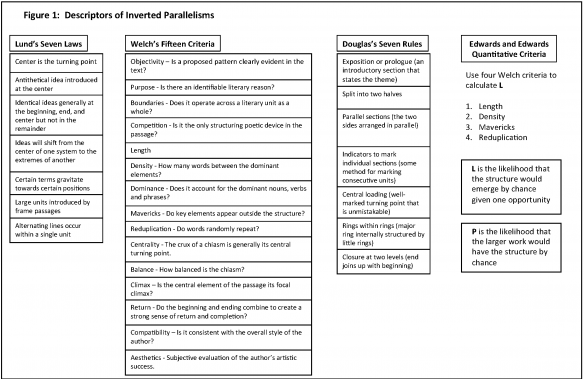
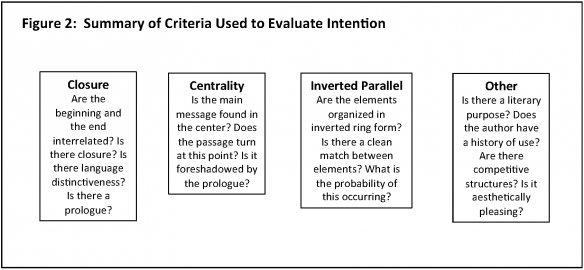
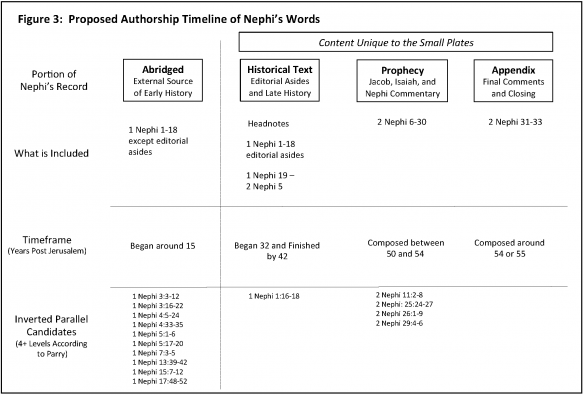
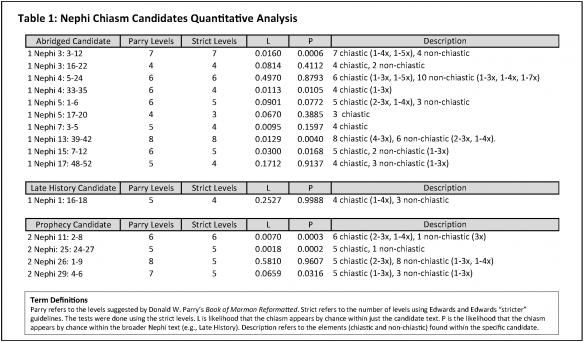
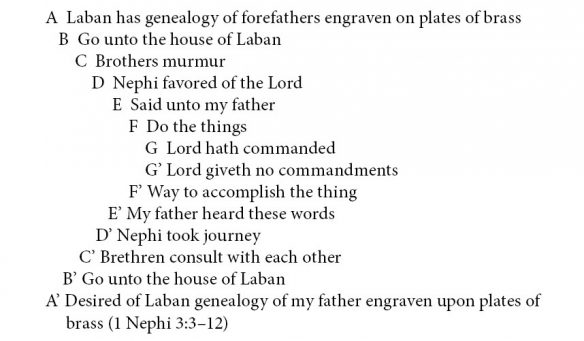
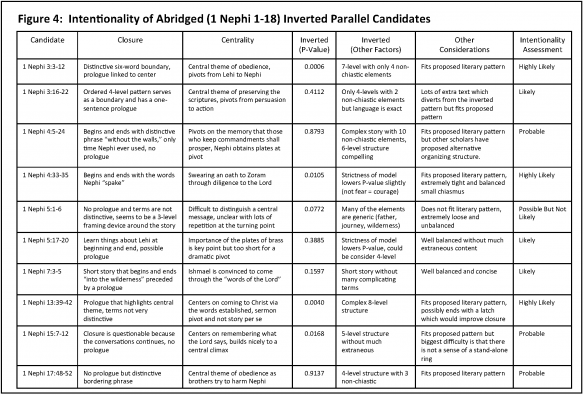

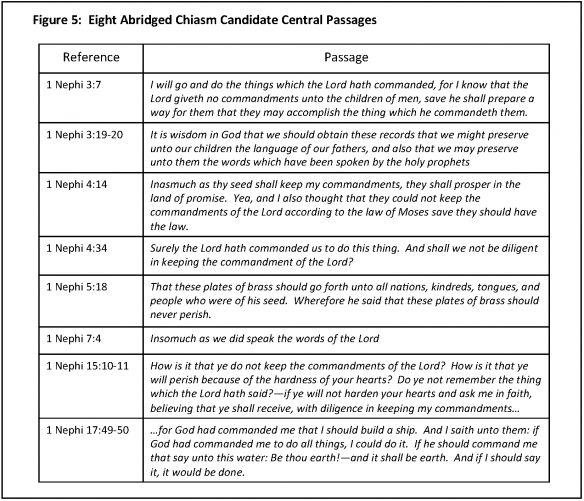
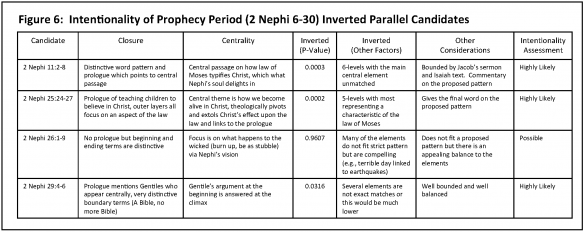
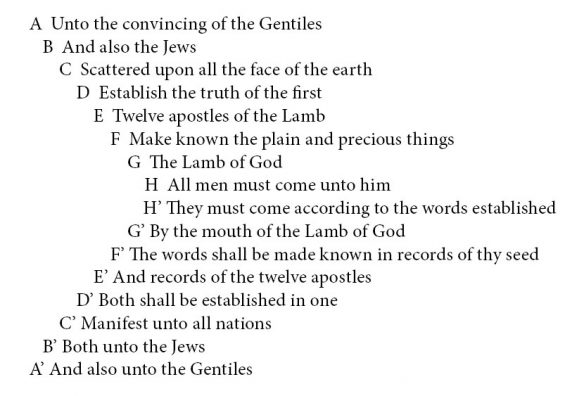
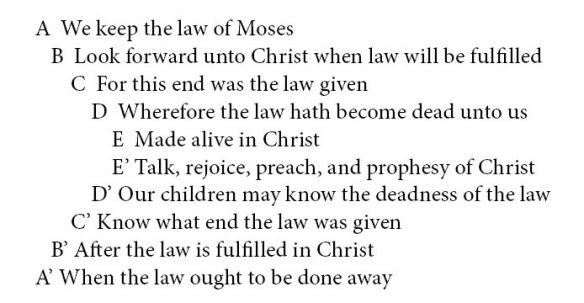
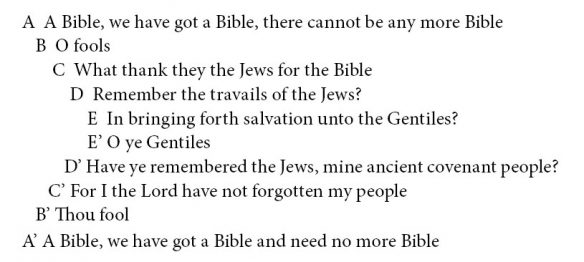
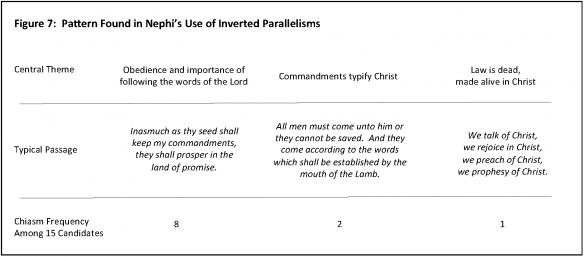
Go here to leave your thoughts on “Nephi’s Use of Inverted Parallels.”